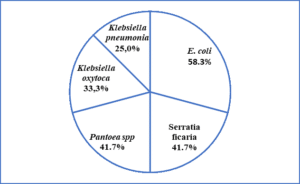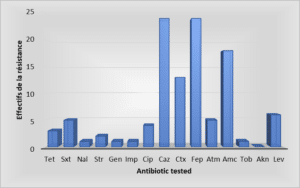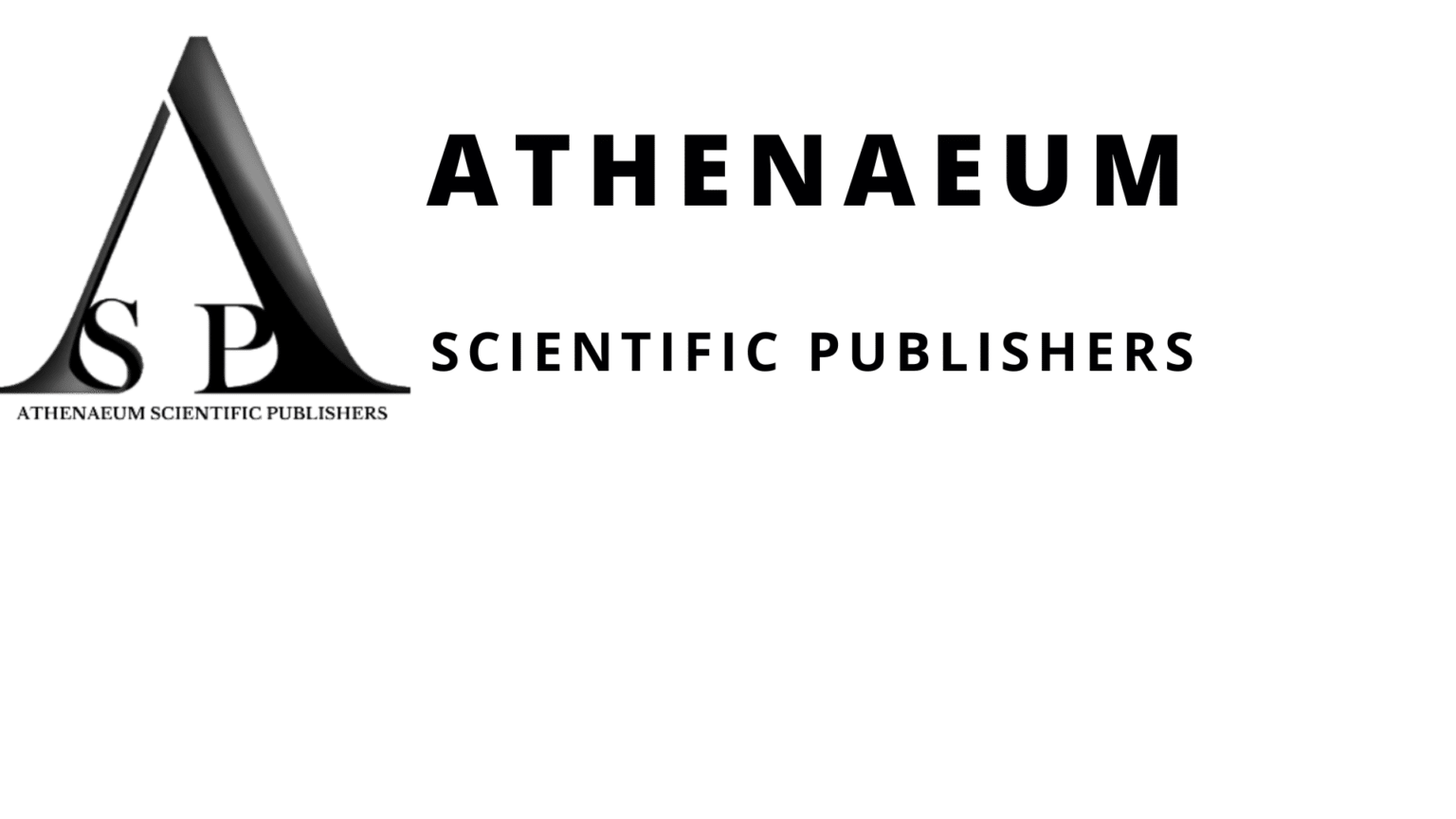Pierre Philippe Mbehang Nguema1*, Yvon-Bert Pambou1, Emelie Arlette Apinda Legnouo1, Roméo Wenscesla Lendamba2, Annicet-Clotaire Dikoumba3, Aimé Loïc Bekale Obame1, Levy Dugauche Nziengui1, Jacques François Mavoungou1
1Institut de Recherche en Écologie Tropicale, Centre National de la Recherche Scientifique et Technologique (IRET/CENAREST), Microbiology Laboratory, PB: 13345 Quartier Gros-bouquet, Libreville, Gabon
2Centre de Recherches Médicales de Lambaréné (CERMEL), Department of Clinical Operations, PB: 242, Lambaréné, Gabon
3Department of Medical Biology, Omar Bongo Ondimba Army Instruction Hospital, PB : 7785 ,Libreville, Gabon
*Correspondence author: Pierre Philippe Mbehang Nguema, Institut de Recherche en Écologie Tropicale, Centre National de la Recherche Scientifique et Technologique (IRET/CENAREST), Microbiology Laboratory, PB: 13345 Quartier Gros-bouquet, Libreville Gabon; Email: [email protected]
Published Date: 17-09-2023
Copyright© 2023 by Nguema PPM, et al. All rights reserved. This is an open access article distributed under the terms of the Creative Commons Attribution License, which permits unrestricted use, distribution, and reproduction in any medium, provided the original author and source are credited.
Abstract
This study aimed to identify antibiotic-resistant Enterobacteriaceae in wastewater discharged into the landfill.
12 samples were collected from the stream point of tanker truck in The MINDOUBÉ municipal landfill to the river were carried out on 29 September 2022. Bacteriological assays performed at the IRET Microbiology Laboratory yielded one bacterial colony per sample once cultured and isolated. Their identification was as follows: Escherichia coli (58.3%), Serratia Ficaria/Pantoea spp (47.1%), Klebsiella oxytoca (33.3%) and Klebsiella pneumoniae (25%). Antibiotic susceptibility tests showed the presence of the following resistances: Ceftazidime and Cefepime (100%), Cefotaxime (54%), Amoxicillin and Clavulanic Acid (75%). Resistance to sulphonamides, quinolones and aminoglycosides was slight. Therefore, these wastewaters are the source of contamination of the neighbouring stream of the MINDOUBE landfill site. The promiscuity of this rubbish dump and the polluted river is thus having a deleterious effect on the health of the people living nearby, to the extent that they use the water from this river to meet their daily household needs. This suggests that the people living in this neighborhood and using the river water are regularly contaminated by multi-resistant bacteria. This could lead to therapeutic failures in managing infectious diseases triggered by these bacteria.
Keywords: Mindoube Municipal Landfill; Wastewater; Enterobacteriaceae; Antibiotic Resistance
Introduction
The urban population increase and the growing demand for consumer goods are leading to rising waste production rates per inhabitant, seriously threatening their living environment [1,2]. Community wastes are usually stored in public landfills such as the MINDOUBE municipal landfill (Libreville) where there is a noticeable melting pot of culture making this a serious public health [3]. MINDOUMBE landfill regularly receives solid waste, liquid waste (wastewater) and pollutants from households, hospitals, businesses, etc, representing an undeniable risk of human contamination by pathogenic bacteria. Wastewater drained by rain could infiltrate the soil and contaminate groundwater or contaminate effluents in the vicinity of the landfill commonly used by the surrounding populations for their daily activities [4]. This wastewater most often harbours a variety of pathogenic microorganisms, such as viruses, bacteria and antibiotic resistance genes [5,6]. Death caused by resistant bacteria are increasing day bay day [6]. Hence the interest of our study, which aims to characterize antibiotic resistance in enterobacteria from wastewater from the MINDOUBE landfill.
Material and Methods
Wastewater Sampling
The MINDOUMBE municipal landfill is located in the MINDOUMBE district, in the 5th arrondissement of Libreville. Sampling was processed at the MINDOUBE landfill between 7 am and 9 am on September 29th 2022. Samples of wastewater were collected at the tanker exit, at the first point of discharge into the landfill and every 30 meters of the runoff towards the river.
The wastewater was collected by filling up sterilized plastic PolyEthylene (PET) bottles of 0.5 litre with the effluent to be analyzed. A total of 12 wastewater samples were collected at various points and distributed as follows:
- Sample E0: collected at the tanker exit
- Sample E1: 1st discharge point at the landfill; 1 sample every 30 meters after E1 (E2, E3)
- Sample E4: sampling at the junction point between wastewater from the landfill and that from theriver
- Samples E5, E6, E7, E8, E9, E10 and E11: taken respectively 30 m downstream of E4
Following sampling, the samples were stored and kept at 4°C in isothermal boxes, then transported to the IRET microbiology laboratory for analysis.
Culture, Isolation and Identification of Bacterial Colonies
Each wastewater sample was centrifuged at a speed of 270 rpm for 2 min at 25°C. After centrifugation, the pellet was recovered and cultured onto Eosin Methylene Blue (EMB) agar medium (Biomérieux, France) using a sterile plastic loop of 1µL and incubed at 37.0±0.5°C for 24 hours. After incubation, all bacterial colonies differentiated by morphology and colour were isolated on a Trypticase soja agar medium (BioMérieux, France). These colonies were identified using the Api 20E galleries (BioMérieux, France) using the ApiWeb software.
Antibiotic susceptibility testing Susceptibility to antibiotics was determined using the Kirby Bauer Mueller-Hinton agar (MH) diffusion disc method [7]. To exhibit the presence of extended-spectrum β-lactamase, the double disc diffusion method was used to test for synergy between 3rd generation cephalosporins and a β-lactamase inhibitor [7]. The inoculum was prepared from a pure culture freshly removed from the incubator. An inoculum suspension was prepared by mixing a few colonies with 700 µL of physiological water (0.9% NaCl) in a sterile 2 mL tube as previously performed by Mbehang, et al. [8].
The following antibiotics were used according to the recommendations of the Clinical Laboratory Standard Institute (CLSI) (Patel, 2015): Amoxicillin + Clavulanic Acid (AMC,20/10µg), Aztreonam (ATM,30µg), Cefepime (FEP,30µg), Cefotaxime (CTX,30µg), Ceftazidime (CAZ,30µg), Ticarcillin + Clavulanic Acid (TTC, 20/10µg), Imipenem (IMP, 10 µg), Tobramycin (TOB, 10µg), Gentamycin (GEN, 10µg), Tetracycline (TET, 30µg), Ciprofloxacin (CIP, 5µg), Nalidixic acid (NAL, 30µg), Trimethoprim + Sulfamethoxazole (SXT, 25µg),Streptomycin(STR,30µg).
The diameter of the zone of inhibition surrounding each test sample disc was measured with a Vernier calliper (Carbon Fiber Composite Digital Caliper, France) and qualitative interpretation was made by comparing the inhibition diameter obtained. The results were classified as Sensible (S), Intermediate (I) or Resistant (R).
Results
Bacterial Identification
The culture and isolation of colonies yielded between one and three colonies per sample. Out of the 12 wastewater samples analyzed, 24 colonies were isolated. The identification of these colonies exhibited that all the bacteria belonged to the Enterobacteriaceae family. E. coli (58.3%, 7/24) was the most prevalent bacteria, followed by Serratia ficaria and Pantoea spp
(41.7%, 5/24), Klebsiella oxytoca (33.3%, 4/24) and Klebsiella pneumoniea (25%, 3/24) (Fig. 1).

Figure 1: Types de detected bacteria.
Antibiotic Susceptibility Testing
The isolated bacteria were more resistant to beta-lactam antibiotics, mainly C3G (CAZ 100%, 24/24; CTX 62.5%, 15/24) and C4G generation (FEP 91.7%, 22/24) and AMC (70.8%, 17/24). The search for ESBL was negative. In addition to beta-lactams, there was resistance to sulphonamides (SXT 20.8%, 5/24), quinolones/fluoroquinolones (LEV 25%, 6/24; CIP 16.7%, 4/24; NAL 4.2%, 1/24) and aminoglycosides (STR 8.3%, 2/24; GEN 4.2%, 1/24; TOB 4.2%, 1/24) (Fig. 2).

Figure 2: Susceptibility to antibiotics.
Yet each enterobacterium is resistant to at least two antibiotics. Table 1 shows that antibiotics for which resistance is found may belong to one, two or three different families. But multidrug resistance does occur when a bacterium expresses resistance to at least 2 antibiotics belonging to at least two different families. These results show that 54.17% (13/24) of bacteria are multi-resistant.
Table 1 shows that the further we move away from the landfill (points E0, E1, E2, E3 and E4), this multi-resistance decreases to between two and three antibiotics. Point E6 (where multi-resistance involves 12 antibiotics) corresponds to the meeting point between wastewater from the MINDOUBE landfill and wastewater from the neighborhood discharged into the river.
|
|
Colonies
|
Bacteria
|
Antibiotics
|
Number of families of ATB |
|||||||||||
|
1 |
E1 (1) |
K. oxytoca |
CAZ |
CTX |
FEP |
ATM |
AMC |
1 |
|||||||
|
2 |
E1 (2) |
S. ficaria |
CIP |
CAZ |
FEP |
AMC |
2 |
||||||||
|
3 |
E1 (3) |
E.coli |
IMP |
CIP |
CAZ |
CTX |
FEP |
AMC |
2 |
||||||
|
4 |
E2 (1) |
S. ficaria |
CAZ |
FEP |
AMC |
1 |
|||||||||
|
5 |
E3 (1) |
K. pneumonia |
CAZ |
CTX |
FEP |
AMC |
LEV |
2 |
|||||||
|
6 |
E3 (2) |
Pantoea spp |
SXT |
CAZ |
CTX |
FEP |
AMC |
LEV |
3 |
||||||
|
7 |
E3 (3) |
E.coli |
TET |
SXT |
CAZ |
FEP |
AMC |
3 |
|||||||
|
8 |
E4 (1) |
Pantoea spp |
CAZ |
CTX |
FEP |
LEV |
2 |
||||||||
|
9 |
E5 (1) |
E.coli |
SXT |
CAZ |
CTX |
FEP |
AMC |
2 |
|||||||
|
10 |
E6 (1) |
K. pneumonia |
CAZ |
FEP |
1 |
||||||||||
|
11 |
E6 (2) |
E.coli |
TET |
SXT |
NAL |
STR |
GEN |
CIP |
CAZ |
CTX |
FEP |
AMC |
TOB |
LEV |
5 |
|
12 |
E7 (1) |
K. oxytoca |
STR |
CAZ |
CTX |
FEP |
2 |
||||||||
|
13 |
E7 (2) |
S. ficaria |
SXT |
CAZ |
CTX |
FEP |
AMC |
2 |
|||||||
|
14 |
E7 (3) |
E.coli |
CAZ |
CTX |
FEP |
AMC |
LEV |
2 |
|||||||
|
15 |
E8 (1) |
S. ficaria |
TET |
CAZ |
CTX |
FEP |
AMC |
2 |
|||||||
|
16 |
E8 (2) |
Pantoea spp |
CAZ |
CTX |
FEP |
1 |
|||||||||
|
17 |
E9 (1) |
K. oxytoca |
CAZ |
FEP |
AMC |
1 |
|||||||||
|
18 |
E9 (2) |
E.coli |
CAZ |
FEP |
AMC |
1 |
|||||||||
|
19 |
E10 (1) |
Pantoea spp |
CIP |
CAZ |
FEP |
LEV |
2 |
||||||||
|
20 |
E10 (2) |
K. pneumonia |
CAZ |
CTX |
FEP |
AMC |
1 |
||||||||
|
21 |
E11 (1) |
S. ficaria |
CAZ |
FEP |
AMC |
1 |
|||||||||
|
22 |
E11 (2) |
E.coli |
CAZ |
FEP |
AMC |
1 |
|||||||||
|
23 |
E12 (2) |
K. oxytoca |
CAZ |
FEP |
AMC |
1 |
|||||||||
|
24 |
E12 (1) |
Pantoea spp |
CAZ |
FEP |
1 |
||||||||||
|
E1 (1): Sample 1 (colony 1), E3 (2): Sample 1 (colony 3), etc. |
|||||||||||||||
Table 1: Phenotypes of bacterial resistance to antibiotics.
Discussion
Prevalence of Enterobacteria in Wastewater
Analytical results showed several species of enterobacteria among these, E. coli appeared to be the most represented (58.3%). The redundancy of E. coli is justified by its high representation within the environment as several studies have shown that E. coli strains are prominently isolated in water [9]. In humans, E. coli is often responsible for diarrhoeal and urinary tract infections, Pantoae spp. can cause bacterial necrosis and many occupational diseases while Serratia fiscaria can be responsible for septicaemia, respiratory and skin diseases [10-13]. Klebsiella spp. is often responsible for urinary tract infections, pulmonary infections, bacteraemia and skin infections and certain respiratory infections [14,15]. These bacteria which can lead to opportunistic infections and threaten human health have already been reported in several bacteriological studies on wastewater even though prevalence rates are lower than those found in our study (6.4% Pantoae spp, 18.6% Klebsiella pneumoniae, 8.5% Klebsiella oxytoca, 16.5% E. coli, 8.3% Serratia spp) [16,17]. Wastewater often harbours abundant Enterobacteriaceae taxa and thus justified the high prevalence rates of isolated Enterobacteriaceae [18].
Antibiotic Susceptibility Testing
In our study, the antibiotic susceptibility test shows that resistance appears to be high for antibiotics from the Beta-lactam family mainly the third and fourth generation Cephalosporins (C3G and C4G) and penicillins, Fluoroquinolones and Tetracyclines. C3G and C4G are widely used to treat recurrent infections such as gastroenteritis, typhoid fever, respiratory diseases and urinary tract infections [19]. Resistance is even high for Amoxicillin+clavulavulanic acid, which is widely used in hospitals to treat Streptococcus infections respiratory and urinary tract infections [20]. Some authors report that the resistance observed for fluoroquinolones (LEV, CIP) and tetracyclines is explained by their use in the treatment of certain urinary tract infections [21,22].
In the human clinic, beta-lactam antibiotics and fluoroquinolones are the most often combined antibiotics in the treatment of infectious diseases [23].
Our results are similar to those observed in a Kenyan study carried out in a landfill by Song’oro, et al., [24]. However, the prevalence of isolated bacteria (10.3% E.coli, 8.3% Klebsiella spp. and 14.1% Serratia spp.) and their resistance to antibiotics (50% FEP, 65% CAZ, 30% AMC, 5% for GEN, 15% TET, 5% LEV, 12% CIP and 8% IMP) determined by these authors appear to be lower than those in our work (see Figure 1 and Figure 2). Some of the wastewater analyzed were originating from hospital effluent in Libreville.
Thus, the results described in this study highlight the fact that hospital effluents are responsible for numerous sources of pathogenic bacteria and antibiotic resistance, sometimes disseminated in rivers. However, more than half of the bacteria identified in this study are multi-resistant to antibiotics (Table 1), with a multiresistance rate of 54.17% (13/24) (bacterial species with resistance to antibiotics belonging to more than 2 different families). Several similar studies have, indeed, shown that a large proportion of enterobacteria in wastewater are multi-resistant to antibiotics [25,26].
Bacterial resistance can spread from one ecosystem to another by waste water from waterways (river, river, etc.) [27]. Soil, surface water and subsoil receive resistant bacteria to antibiotics from hospital effluents, population discharges and animal remains, throughout urban rivers tributaries, mix and interact with or ganisms in the environment such as pollutants [28]. Pollutants are known to induce expression of antibiotic-resistance genes [29]. Since a decrease in bacterial resistance was observed in our study (Table 1) as we move further away from the wastewater discharge point, the MINDOUBE landfill may therefore be responsible for the environmental pollution of this site via the large-scale dispersal of multi-drug-resistant bacteria. In addition, all the resistance profiles determined here highlight that the studied enterobacteria are multi-resistant. The appearance of bacteria that are multi-resistant to antibiotics makes it more difficult to combat bacterial infections and resulting in complex and long-lasting illnesses with a potentially increased number of dead due to bacterial infections these strains might induce [11,31]. Ultimately, wastewater from the MINDOUBE landfill could be a potential niche for antibiotic-resistant strains in the Gabonese capital and its surroundings.
Conclusion
Wastewater from the MINDOUBE landfill (Libreville) has several origins including hospital effluent, household waste, industrial discharge, etc. This water is likely to induce significant disturbance in the health of local population with their multiresistant bacteria. The river downstream is therefore heavily polluted and disturbed by the presence of this landfill. The present study highlights the danger posed by wastewater from the MINDOUBE landfill which constitutes a proliferation area for some multiresistant pathogenic bacteria capable to inducing therapeutic failures in treating infectious diseases and therefore resulting in human death.
Acknowledgement
Researchers from the Institut de Recherche en Ecologie Tropicale (IRET) collaborated on this study. Special thanks go to the Gabonese authorities, IRET and CENAREST for providing the research permits. Our thanks also go to the Clean Africa Gabon executive team for facilitating wastewater sampling at the MINDOUMBE municipal landfill they manage.
Conflict of Interest
The authors have no conflict of interest to declare.
References
- Idris A, Inanc B, Hassan MN. Overview of waste disposal and landfills/dumps in Asian countries. J Material Cycles and Waste Management. 2004;6:104-10.
- Boadi K, Kuitunen M, Raheem K, Hanninen K. Urbanisation without development: environmental and health implications in African cities. Environment, Development and Sustainability. 2005;7:465-500.
- Schiopu AM, Gavrilescu M. Municipal solid waste landfilling and treatment of resulting liquid effluents. Environmental Engineering & Management Journal (EEMJ). 2010;9(7).
- Harter T, Rollins L. Watersheds, groundwater and drinking water: A practical guide. UCANR Publications. 2008.
- Jassim SA, Limoges RG, El-Cheikh H. Bacteriophage biocontrol in wastewater treatment. World J Microbiol Biotechnol. 2016;32(4):70.
- Kumar A, Pal D. Antibiotic resistance and wastewater: Correlation, impact and critical human health challenges. J Environ Chem Engineer. 2018;6(1):52-8.
- Bauer AW, Kirby WM, Sherris JC, Turck M. Antibiotic susceptibility testing by a standardized single disk method. Am Clin Pathol. 1966;45(4):493.
- Mbehang Nguema PP, Onanga R, Ndong Atome GR, Tewa JJ, Mabika Mabika A, Muandze Nzambe JU, et al. High level of intrinsic phenotypic antimicrobial resistance in enterobacteria from terrestrial wildlife in Gabonese national parks. Plos One. 2021;16(10):e0257994.
- Leo S, Lazarevic V, Girard M, Gaïa N, Schrenzel J, de Lastours V, et al. Metagenomic characterization of gut microbiota of carriers of extended-spectrum beta-lactamase or carbapenemase-producing Enterobacteriaceae following treatment with oral antibiotics and fecal microbiota transplantation: results from a multicenter randomized trial. Microorganisms. 2020;8(6):941.
- Schultz M. Clinical use of coli Nissle 1917 in inflammatory bowel disease. Inflammatory Bowel Diseases. 2008;14(7):1012-8.
- Xiao L, Yang X, Li J, Zhang P, Tang S, Cao D, et al. Caerin 1 peptides, the potential Jack-of-all-trades for the multiple antibiotic-resistant bacterial infection treatment and cancer immunotherapy. BioMed Res Int. 2022;2022.
- Büyükcam A, Tuncer Ö, Gür D, Sancak B, Ceyhan M, Cengiz AB, et al. Clinical and microbiological characteristics of Pantoea agglomerans infection in children. J Infection and Public Health. 2018;11(3):304-9.
- Dalamaga M, Pantelaki M, Karmaniolas K, Matekovits A, Daskalopoulou K. Cutaneous abscess and bacteremia due to Serratia ficaria. J Euro Acad Dermatol Venereol. 2008;22(11):1388-9.
- Yang J, Long H, Hu Y, Feng Y, McNally A, Zong Z. Klebsiella oxytoca complex: update on taxonomy, antimicrobial resistance and virulence. Clinical microbiology reviews. 2022;35(1):e00006-21.
- Neghab M, Jabari Z, Shouroki FK. Functional disorders of the lung and symptoms of respiratory disease associated with occupational inhalation exposure to wood dust in Iran. Epidemiology and Health. 2018;40.
- Malaho C, Wawire SA, Shivoga WA. Antimicrobial resistance patterns of Enterobacteriaceae recovered from wastewater, sludge and dumpsite environments in Kakamega town, Kenya. African J Microbiol Res. 2018;12(28):673-80.
- Mechai A, Debabza M, Thabet R, Sedira H, Fadeleddine S, Mechai A. Occurrence and spread of beta-lactamases-producing Enterobacteriaceae isolated from river receiving treated effluent of wastewater treatment plant. Desal Water Treatment. 2019;147:156-63.
- Nakamura-Silva R, de Sousa RC, Fujimoto RY, Pitondo-Silva A. Sewage from a secondary hospital in Ribeirão Preto, southeastern Brazil: a source of multidrug-resistant Enterobacteriaceae. Environmental Monitoring and Assessment. 2023;195(1):204.
- Brink AJ, Cotton MF, Feldman C, Finlayson H, Friedman RL, Green R, et al. Updated recommendations for the management of upper respiratory tract infections in South Africa. SAMJ: South African Medical J. 2015;105(5):345-52.
- Huttner A, Bielicki J, Clements MN, Frimodt-Møller N, Muller AE, Paccaud JP, et al. Oral amoxicillin and amoxicillin–clavulanic acid: properties, indications and usage. Clin Microbiol Infection. 2020;26(7):871-9.
- Kline JM, Wietholter JP, Kline VT, Confer J. Pediatric antibiotic use: a focused review of fluoroquinolones and tetracyclines. US Pharm. 2012;37(8):56-9.
- Rerambiah LK, Ndong JC, Massoua PM, Medzegue S, Elisee-Ndam M, Mintsa-Ndong A, et al. Antimicrobial profiles of bacterial clinical isolates from the Gabonese National Laboratory of Public Health: data from routine activity. Int J Infectious Dis. 2014;29:48-53.
- Germanos GJ, Trautner BW, Zoorob RJ, Salemi JL, Drekonja D, Gupta K, et al. No clinical benefit to treating male urinary tract infection longer than seven days: an outpatient database study. InOpen Forum Infectious Dis. 2019;6(6):216.
- Song’oro E, Nyerere A, Magoma G, Gunturu R. Occurrence of highly resistant microorganisms in Ruai wastewater treatment plant and dandora dumpsite in Nairobi County, Kenya. Advances in Microbiol. 2019;9(5):479-94..
- Chen J, McIlroy SE, Archana A, Baker DM, Panagiotou G. A pollution gradient contributes to the taxonomic, functional and resistome diversity of microbial communities in marine sediments. Microbiome. 2019;7:1-2.
- Djebrouni T, Belamri B, Faradji-Hamma SE. Enquête épidémiologique sur les maladies infectieuses chez l’enfant et isolement des souches incriminées. 2008.
- Machado EC, Freitas DL, Leal CD, de Oliveira AT, Zerbini A, Chernicharo CA, et al. Antibiotic resistance profile of wastewater treatment plants in Brazil reveals different patterns of resistance and multi resistant bacteria in final effluents. Science Total Environment. 2023;857:159376.
- Khan NA, Ahmed S, Farooqi IH, Ali I, Vambol V, Changani F, et al. Occurrence, sources and conventional treatment techniques for various antibiotics present in hospital wastewaters: a critical review. TrAC Trends in Analytical Chemistry. 2020;129:115921.
- Savin M, Bierbaum G, Hammerl JA, Heinemann C, Parcina M, Sib E, et al. Antibiotic-resistant bacteria and antimicrobial residues in wastewater and process water from German pig slaughterhouses and their receiving municipal wastewater treatment plants. Science of The Total Environment. 2020;727:138788.
- Chen X, Sun Q, Tang L, Guo T, Huang S, Mo J, et al. First report of bacterial necrosis caused by Pantoea vagans in mango in China. Plant Disease. 2023;107(6):1935.
- Micek ST, Wunderink RG, Kollef MH, Chen C, Rello J, Chastre J, et al. An international multicenter retrospective study of Pseudomonas aeruginosa nosocomial pneumonia: impact of multidrug resistance. Critical Care. 2015;19:1-8.
Article Type
Research Article
Publication History
Received Date: 22-08-2023
Accepted Date: 10-09-2023
Published Date: 17-09-2023
Copyright© 2023 by Nguema PPM, et al. All rights reserved. This is an open access article distributed under the terms of the Creative Commons Attribution License, which permits unrestricted use, distribution, and reproduction in any medium, provided the original author and source are credited.
Citation: Nguema PPM, et al. Resistance of Enterobacteriaceae to Antibiotics in Wastewaters From the Mindoube Municipal Landfill (Libreville, Gabon). J Clin Immunol Microbiol. 2023;4(3):1-7.

Figure 1: Types de detected bacteria.

Figure 2: Susceptibility to antibiotics.
| Colonies
| Bacteria
| Antibiotics
| Number of families of ATB | |||||||||||
1 | E1 (1) | K. oxytoca | CAZ | CTX | FEP | ATM | AMC | 1 | |||||||
2 | E1 (2) | S. ficaria | CIP | CAZ | FEP | AMC | 2 | ||||||||
3 | E1 (3) | E.coli | IMP | CIP | CAZ | CTX | FEP | AMC | 2 | ||||||
4 | E2 (1) | S. ficaria | CAZ | FEP | AMC | 1 | |||||||||
5 | E3 (1) | K. pneumonia | CAZ | CTX | FEP | AMC | LEV | 2 | |||||||
6 | E3 (2) | Pantoea spp | SXT | CAZ | CTX | FEP | AMC | LEV | 3 | ||||||
7 | E3 (3) | E.coli | TET | SXT | CAZ | FEP | AMC | 3 | |||||||
8 | E4 (1) | Pantoea spp | CAZ | CTX | FEP | LEV | 2 | ||||||||
9 | E5 (1) | E.coli | SXT | CAZ | CTX | FEP | AMC | 2 | |||||||
10 | E6 (1) | K. pneumonia | CAZ | FEP | 1 | ||||||||||
11 | E6 (2) | E.coli | TET | SXT | NAL | STR | GEN | CIP | CAZ | CTX | FEP | AMC | TOB | LEV | 5 |
12 | E7 (1) | K. oxytoca | STR | CAZ | CTX | FEP | 2 | ||||||||
13 | E7 (2) | S. ficaria | SXT | CAZ | CTX | FEP | AMC | 2 | |||||||
14 | E7 (3) | E.coli | CAZ | CTX | FEP | AMC | LEV | 2 | |||||||
15 | E8 (1) | S. ficaria | TET | CAZ | CTX | FEP | AMC | 2 | |||||||
16 | E8 (2) | Pantoea spp | CAZ | CTX | FEP | 1 | |||||||||
17 | E9 (1) | K. oxytoca | CAZ | FEP | AMC | 1 | |||||||||
18 | E9 (2) | E.coli | CAZ | FEP | AMC | 1 | |||||||||
19 | E10 (1) | Pantoea spp | CIP | CAZ | FEP | LEV | 2 | ||||||||
20 | E10 (2) | K. pneumonia | CAZ | CTX | FEP | AMC | 1 | ||||||||
21 | E11 (1) | S. ficaria | CAZ | FEP | AMC | 1 | |||||||||
22 | E11 (2) | E.coli | CAZ | FEP | AMC | 1 | |||||||||
23 | E12 (2) | K. oxytoca | CAZ | FEP | AMC | 1 | |||||||||
24 | E12 (1) | Pantoea spp | CAZ | FEP | 1 | ||||||||||
E1 (1): Sample 1 (colony 1), E3 (2): Sample 1 (colony 3), etc. | |||||||||||||||
Table 1: Phenotypes of bacterial resistance to antibiotics.


